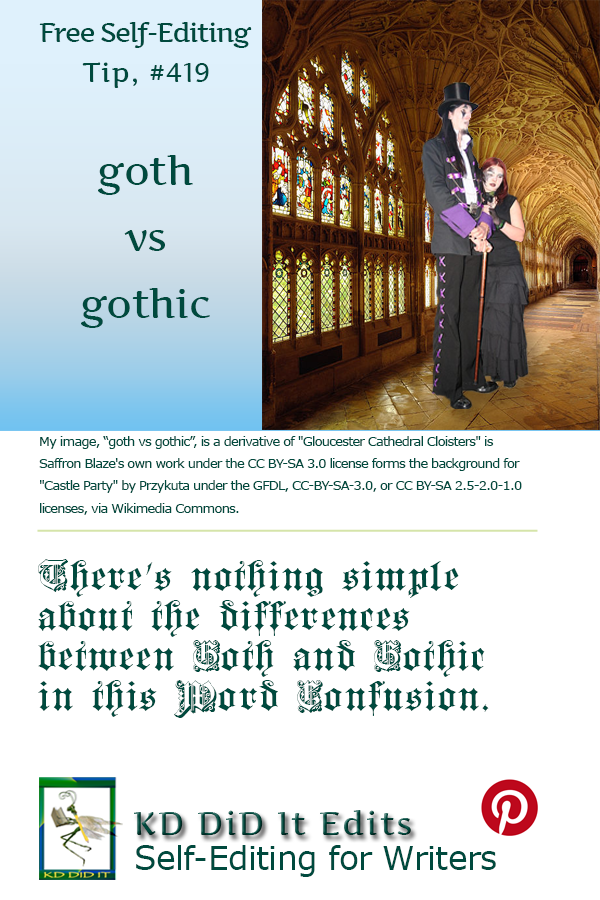Revised as of
22 Nov 2022
This is one of my own problem word confusions, and I’ve been meaning to make notes on when either word is lowercase or capitalized, when goth is preferable to gothic, etc.
Turns out that both words are capitonyms — each word should be lowercased or uppercased depending upon its context (if not specified in the definitions below, the term is usually lowercased).
It becomes quite complex with Goth and Gothic both referring to an East Germanic people who appeared approximately between 76 and 400 C.E., and a lowercase version referring to a barbarian-like person OR the modern-day goth culture of fashion, music, and dark thoughts.
When it comes to architecture, decoration, literature, typefaces, or Middle Ages art, it appears as if gothic/Gothic is the preferred term. Yes, the initial letter may be lower- or upper-case unless you are specifically referring to an historical period or era when it should be capitalized. The key in this case is consistency, whichever you choose, use the same “spelling” throughout. In general, you’re probably safest in lowercasing either word if referring to today’s goth culture and uppercasing it in any other reference.
Word Confusions . . .
. . . started as my way of dealing with a professional frustration with properly spelled words that were out of context in manuscripts I was editing as well as books I was reviewing. It evolved into a sharing of information with y’all. I’m hoping you’ll share with us words that have been a bête noire for you from either end.
If you found this post on “Goth versus Gothic” interesting, consider tweeting it to your friends. Subscribe to KD Did It, if you’d like to track this post for future updates.
| Goth | Gothic |
|---|---|

Goth is Rama’s own work under the CC BY-SA 2.0 fr licenses, via Wikimedia Commons. — A goth couple at the Eurockéennes of 2007. |

Prague Cathedral is MathKnight’s and Zachi Evenor’s own work under the GFDL, CC-BY-SA-3.0, CC BY 2.5, or CC BY 3.0 licenses, via Wikimedia Commons. — An example of Gothic architecture. |
| Part of Grammar: | |
| Uncountable Noun
Plural: goths, Goths |
Adjective; Noun
Plural for the noun: Gothic Alternate archaic spelling: Gothick |
| [Capitalized] A member of a Germanic people that invaded the Roman Empire from the east between the 200 and 400 C.E.
A style of rock music derived from punk, typically with apocalyptic or mystical lyrics
A person of no refinement
|
Adjective: [Usually capitalized] Pertaining to the Middle Ages (500 to 1500 C.E.; the Dark Ages, a.k.a., the Early Middle Ages, spanned 500 and 1000 C.E.)
Barbarous or crude [Architecture; usually capitalized] Of or in the style of architecture prevalent in western Europe in the 1100 to 1500 C.E., characterized by pointed arches, rib vaults, and flying buttresses, together with large windows and elaborate tracery [Art; usually capitalized] Pertaining to or designating the style of painting, sculpture, etc., produced between the 1300 and 1500 C.E., especially in northern Europe, characterized by a tendency toward realism and interest in detail [Fashion] Relating to goths
[Linguistics; capitalized] Relating to the Goths or their extinct East Germanic language, which provides the earliest manuscript evidence of any Germanic language (300–500 C.E.) [Literature; usually capitalized] Noting or pertaining to a style of literature especially popular in the late 18th century characterized by a gloomy setting, grotesque, mysterious, supernatural, or violent events, and an atmosphere of degeneration and decay
[Music] In a style of guitar-based rock with some similarities to heavy metal and punk and usually characterized by depressing or mournful lyrics [Music; usually capitalized] Of or relating to the music, especially of northern Europe, of the period roughly from 1200 to 1450, including that of the Ars Antiqua, Ars Nova, and the Burgundian school [Typeface] Of or derived from the angular style of handwriting with broad vertical downstrokes used in western Europe from the 1200s C.E., including Fraktur and blackletter typefaces Noun: [Usually capitalized] Gothic art style, architecture, or decoration [Linguistics; capitalized] The East Germanic language of the Goths [Literature] A novel, film, play, or other work in the gothic style A rude or barbaric person An aficionado of goth music and fashion [Typeface] A square-cut printing type without serifs or hairlines |
| Examples: | |
| The Ostrogoths, the eastern Goths, founded a kingdom in Italy while the Visigoths went on to found one in Spain.
Gothus is said to be the mythical founder of the Goths. Dressed in black shirts and pants and wearing that pale makeup? They must be goths. Mary had been into goth for years. We saw a goth hanging out at the library. One goth fan sees Evanescence’s songs as deep and meaningful while another prefers The Cure. |
Adjective: It was a 19th-century Gothic horror story. Horace Walpole’s The Castle of Otranto, written in 1764, is considered a classic gothic romantic horror. A modern-day gothic novel is Susan Hill’s The Woman in Black. In 13th century France, Gothic music was “characterized by increasingly sophisticated counterpoint” (Editors ). Noun: The flying buttress is the defining external characteristic of gothic architecture. Using stone gargoyles as rain gutters is but one example of the creativity of Gothic architecture. Blackletter (sometimes called Old English) is a type of gothic script used between the 17th and 20th centuries. Notre Dame and Chartres Cathedral in France are excellent examples of Gothic architecture. |
| Derivatives: | |
| Adjective: gothlike, non-Gothic, post-Gothic, pre-Gothic Adverb: gothically Noun: Gothicizer, Gothicism, Gothiciser, gothicness, gothicity, pre-Gothic Verb, transitive: Gothicise, Gothicized, Gothicising [British with the s), Gothicize, Gothicized, Gothicizing |
|
| History of the Word: | |
| Old English Gota was superseded in Middle English by the adoption of the late Latin Gothi (plural), from the Greek Gothoi, which is from the Gothic Gutthiuda meaning the Gothic people. | From the French gothique or late Latin gothicus, which is from Gothi (see Goth).
It was used in the 17th and 18th centuries to mean not classical, i.e., not Greek or Roman, and hence to refer to medieval architecture that did not follow classical models and a typeface based on medieval handwriting. |
C’mon, get it out of your system, bitch, whine, moan . . . which words are your pet peeves? Also, please note that I try to be as accurate as I can, but mistakes happen or I miss something. Email me if you find errors, so I can fix them . . . and we’ll all benefit!
Satisfy your curiosity about other Word Confusions on its homepage or more generally explore the index of self-editing posts. You may also want to explore Book Layout & Formatting Ideas, Formatting Tips, Grammar Explanations, Linguistics, Publishing Tips, the Properly Punctuated, Writing Ideas and Resources, and Working Your Website.
Resources for Goth versus Gothic
Some of these links may be affiliate links, and I will earn a small percentage, if you should buy it. It does not affect the price you pay.
Apple Dictionary.com
The Editors of Encyclopaedia Britannica. “Ars Antiqua.” Encyclopaedia Britannica. n.d. Web. n.d. <https://www.britannica.com/art/Ars-Antiqua>.
Pinterest Photo Credits:
Gloucester Cathedral Cloisters (image reversed) is Saffron Blaze’s (<http://www.mackenzie.co>) own work under the CC BY-SA 3.0 license forms the background for Castle Party (background removed) by Przykuta under the GFDL, CC-BY-SA-3.0, or CC BY-SA 2.5-2.0-1.0 license, via Wikimedia Commons.
On a side note, the Gloucester Cathedral cloisters are the earliest surviving fan vaults, having been constructed in the mid-14th century and were used in several of the Harry Potter films.


